Apple's iPhone 4: Thoroughly Reviewed
by Brian Klug & Anand Lal Shimpi on June 30, 2010 4:06 AM EST- Posted in
- Smartphones
- Apple
- iPhone 4
- Gadgets
- Mobile
Screen - Retina Display
Right out of the box, the iPhone 4's new 326 PPI, 960x640, 3.5" display is arguably the single most striking change the new iPhone brings. In a word, it's dazzling. Text and high res images look amazingly sharp on the iPhone 4’s retina display. It’s an improvement over the 800 x 480 AMOLED screens that have been shipping on most Android phones. But if you’re comparing it to an iPhone 3GS the difference is huge.
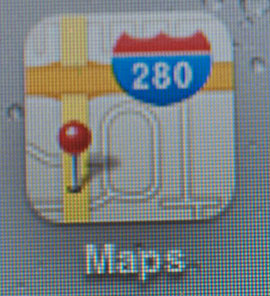 |
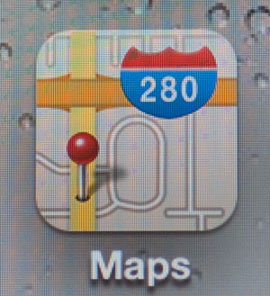 |
|
iPhone 3GS
|
iPhone 4
|

Text on the Google Nexus One

Text on the iPhone 4
The dot pitch is truly remarkable, so much so that Apple makes the claim that their display outresolves the human eye; its advertised ability to do so has earned it a new Apple tradename, "retina display."
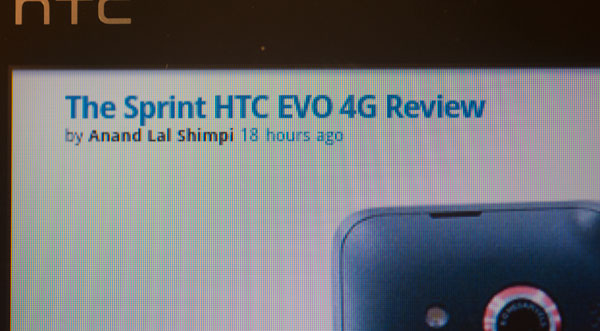
Text on the HTC EVO 4
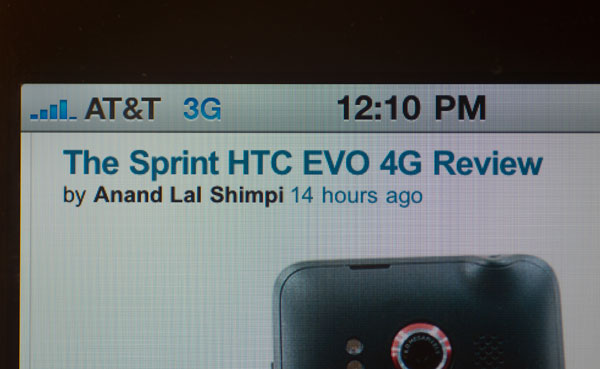
Text on the iPhone 4
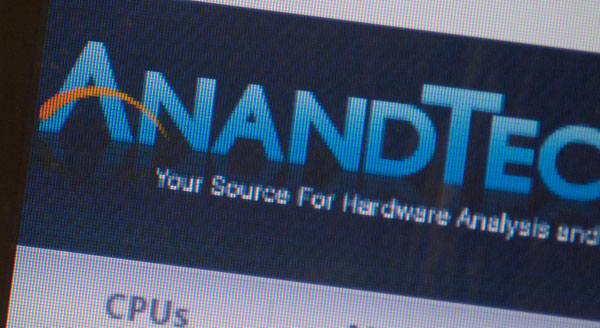
AnandTech Logo on the EVO 4G

AnandTech Logo on the iPhone 4
Immediately after hearing Apple's claim that the Retina Display outresolves the human eye, I snapped into optics mode and crunched the numbers, and tweeted that the results were valid.
In the days that followed, there was considerable debate about the validity of Apple's claims. However, nearly all of the debate really just hinged on a debate over angular resolution of the human eye, and a little more over viewing distance. They're both entirely conventions.
As you've probably discovered by now, the human eye resolution can really only be characterized in angular subtense. Hold something closer to your eye, and you can see smaller features better (in theory), move it further away, and you can't make out small spatial details. The minimum angle visible with the human eye is the angle at which features (for the most common definition, a black and white square wave) stop being visible, and are indistinguishable from each other.
Most measures of visual acuity test with this implicitly - the Snellen eye chart's use of the capital "E" is literally a perfect example, which has given rise to a "tumbling E" eye chart. At twenty feet, the capital E subtends 5 minutes of arc, and conveniently has five half cycles of white to black (from top to bottom). So 20/20 implicitly implies an angular resolution of 1 arcminute (1/60 degrees).
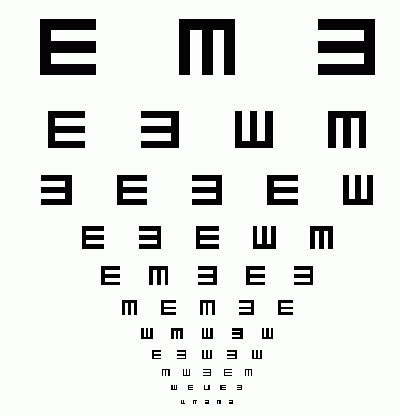
As an Optical Sciences and Engineering undergrad, I've had 1 arcminute drilled into my head more times than I can count as being the "normal" angular resolution of the human eye system. In practice, this is 20/20 vision, which is "normal," yet not perhaps the absolute maximum for human perfection. We can play games of course and argue that a small subset of the population has better than normal uncorrected vision, and thus an angular resolution of below 1 arcminute. I have above average uncorrected vision, which I've measured to be 20/15 on average, giving an angular resolution of approximately 0.75 arcminutes. Of course, the definitions stem from the spacing of cones in the fovea, the highest resolution part of the retina.
The other informational quantity needed to test the Retina Display claims is viewing distance. Again, there's a commonly agreed upon convention - standard viewing distance is considered to be 1 foot. This is another drilled into my brain number tossed around for comfortable viewing and reading. In practice, you can focus on objects much closer to your eye - this is called the near point and is often given as 10 inches, though as you get closer you increase strain aren't likely to keep it here.

Maybe not exactly the limit, but close enough.
Given the two most common standards tossed around, 1 arcminute and 12 inches, do the math out and you'll arrive at around 286 pixels per inch as the limit for eye resolving power, comfortably below the 326 on the Retina Display. Move to 0.75 arcminutes at 12 inches, and it's 382 pixels per inch, higher than the Retina Display. Honestly, I can't see the pixels at 12 inches.
Of course, the real story is even more complicated. Remember how the definition comes with the implicit assumption that we're dealing with a square wave pattern from white to black? That's a factor too - the contrast of the two pixels. Lower the contrast, and the eye's ability to pick out features decreases even more. So far, everything we've talked about has been first order, and without aberrations. Toss in spherical and astigmatism, two aberrations common to the eye system, and eye performance drops way more.
The human eye system is actually pretty poor, and shockingly easy to outresolve. In fact, if you saw the image your eye forms on your retina, you'd likely be appalled; it's your brain that makes the system usable. But at the end of the day, Apple's claims that the display outresolves the human eye are good enough for us.










270 Comments
View All Comments
strikeback03 - Tuesday, July 6, 2010 - link
I would assume they were referring to the launch of Windows Phone 7, which may prove to be a viable smartphone competitor. But being still months away that is a long time for competitors to move ahead.Also, as far as hardware goes, there are phones built with modern hardware, such as the HTC HD2. The software is the real problem.
softdrinkviking - Sunday, July 4, 2010 - link
the biggest turn off for me is still the lack of micro SD support.i use my phone as my primary mp3 player, and i end up filling up 16GB really quickly.
with SD cards, you can swap out your storage on the go, rather than having to return home and do a sync in itunes.
also, itunes is awful. it's such a pain in the ass to use, and i can think of no good reason that we can't drag and drop mp3 files onto our phones, or better yet, onto SD cards. (other than the fact that apple wants to force you to go through their online marketplace on a regular basis)
D3lta - Sunday, July 4, 2010 - link
By far the best review I've ever read. Thanks and keep up the good work.avoidz - Sunday, July 4, 2010 - link
Cynical maybe, but I'm sure this was all part of the plan, knowing that users would require the $30 bumper case.Consolidated - Sunday, July 4, 2010 - link
A rough (eyeball) estimate of your diagram finds the umts antenna to be about twice as long as the WiFi antenna. Connecting the two would increase the length of the umts antenna about 50%, midway between the base length and the first harmonic length. Nasty VSWR there.The same calculus INCREASES the wifi antenna length by a factor of three, just about the second harmonic (an odd harmonic, yes but way better than midway between, no?).
zero01 - Sunday, July 4, 2010 - link
This is a must have, I hear it fixes everythingVery funny although I cant see them selling many.
docflash - Sunday, July 4, 2010 - link
as a physician, i've had lots of patients who've had allergies to metal - nickel in particular. an effective fix is coating the metal, often in a ring or other piece of jewelry, with a couple of layers of clear nail polish. this doesn't allow their skin to touch the metal, and stops the allergy.it's *possible* that some clear nail polish would have the same effect on the metal of the iP4's antenna. now, i am not an engineer (nor do i play one on TV) but i see no reason this won't work. and if it does: well, i'm in the market for a new phone, and the iP4 could be it.
if it *does* work for you, great! but share the news - i'd like to try it myself (and so might other folks).
scubasteve03 - Monday, July 5, 2010 - link
I have searched everywhere! Where can I find that the background on the home screen in the " The Real Story on iPhone 4's Antenna" section? It has the vertical stripes that is yellow and black. If anyone could please help me figure out where to get send me an email. First person to find it for me gets 10 internet points! selphs03@gmail Thanks everyone!Romion - Monday, July 5, 2010 - link
First of all, regarding battery life I dont think that the real talk time is bigger than what Apple announced (about 7h). I know from experience that all my phones till now had talk times around 1/2 up to 2/3 of what manufacturer announced (the talk time announced is IDEAL, most probably non existent in real life.) Just curios, how did u check the talk time?BUT, MAYBE THIS IS A MAGICAL DEVICE AND I AM ALL WRONG.
Anand, if u use some technical data this doesnt mean that they are correct/ true and we can rely on this review.
U said that u were in line at mall for every Iphone model till now, well, that tell us/me everything.
Sorry if my english is not perfect, im not a native english speaker, but a smart enough guy to see things how they are in reality and not listen to others in their bias reviews.
gl
Stoli89 - Monday, July 5, 2010 - link
It would be interesting to understand if changes to the WiFi/Bluetooth/GPS portion of the antenna system has an impact on the 2G/3G portion. If energy from wifi and/or bluetooth and/or GPS is causing interference with the 2G/3G signal processing when the so-called "gap" is conductively bridged. Current test seem to focus on the 2G/3G antenna being de-tuned when the external antenna gap is bridged, without considering if energy is also leaking through and corrupting the 2G or 3G signal(s). Just curious if this is just one more parameter which has confused the outcomes for different customers.